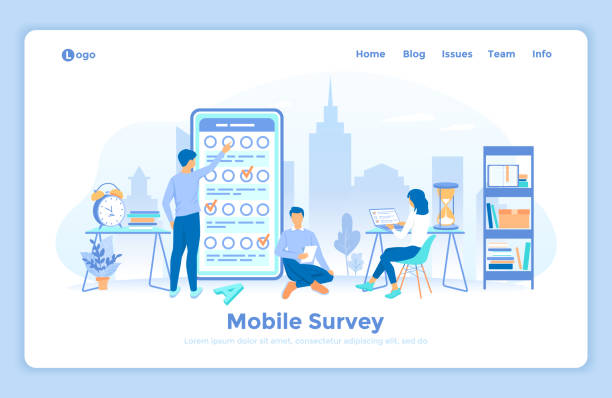Introduction to Responsive Website Design: Why Flexibility Matters?

In today’s digital world, where devices and screen sizes are constantly changing and evolving, the concept of #Responsive_Web_Design is no longer a luxury choice, but a vital necessity.
This leading approach in web design ensures that your website has an excellent appearance and flawless performance, regardless of the device (desktop computer, laptop, tablet, or smartphone) or screen size the user accesses it from.
The main goal of responsive website design is to create a seamless and optimized user experience where content intelligently adapts to the available space and navigation remains easy.
This not only improves user satisfaction but also plays a key role in increasing your site’s ranking in search engines, as engines like Google give higher scores to sites with a good mobile experience.
Undoubtedly, investing in responsive website design is an essential step for any business seeking sustainable success in the online space.
This approach ensures that your site is resistant to future technological changes and you won’t need frequent redesigns.
Is your e-commerce website ready to attract maximum customers and increase sales? Rasaweb transforms your online business with modern and efficient e-commerce website designs.
✅ Increased speed and improved SEO
✅ Excellent user experience on mobile and desktop⚡ Get a free e-commerce website design consultation from Rasaweb!
Key Principles of Responsive Design: Fluid Grids, Flexible Images, and Media Queries

To achieve a truly effective #Responsive_Website, it is essential to understand and apply its three fundamental principles.
The first principle is #Fluid_Grids.
Instead of using fixed pixel dimensions for layout elements, responsive design uses percentage values (relative to the parent’s width).
This means that the width of columns, margins, and spaces are dynamically adjusted with screen size changes, keeping the overall site layout always proportional and beautiful.
The second principle is #Flexible_Images.
Images and videos can disrupt responsive layouts if not managed correctly.
By using CSS and setting the property max-width: 100%, it can be ensured that images never exceed the width of their parent element and are automatically scaled to fit within the available space.
This prevents issues like content overflow or unnecessary horizontal scrolling.
Finally, the most powerful tool in responsive website design is #Media_Queries.
This capability in CSS3 allows you to apply a set of styles only when specific conditions (such as screen width, orientation, or resolution) are met.
For example, you can define a larger font for mobile devices, change navigation to a hamburger menu, or stack layout columns vertically.
By combining these three principles, responsive website design not only creates a website compatible with various devices but also provides an efficient and pleasant experience for users.
Benefits of Responsive Website Design for Your Business: Why Should You Invest?

In the current digital age, choosing responsive website design for any business goes beyond a technical decision; it’s a vital strategy for growth and survival in a competitive market.
One of the most important advantages is improved #User_Experience.
A site that displays well on any device encourages users to stay longer and interact more.
This, in turn, reduces the #Bounce_Rate and increases the #Conversion_Rate, as users can easily access the information they need and perform desired actions (such as purchasing or registering).
From an #SEO perspective, Google has explicitly stated that it prefers responsive website design due to better user experience and ease of crawling.
Responsive websites usually have a single URL and a single source code, which helps search engines index content more effectively and prevents duplicate content issues that arise with separate mobile sites.
Furthermore, maintaining a responsive site is much easier and more cost-effective than maintaining several separate versions (for desktop and mobile).
You only need to manage one codebase, which leads to reduced development and support costs.
This also makes content updates and new changes faster and more efficient.
| Feature | Responsive Website Design | Separate Mobile Site |
|---|---|---|
| Number of URLs | Unique for all devices | Multiple (e.g., m.example.com) |
| Codebase | Single and integrated | Two or more separate codebases |
| Development and Maintenance Cost | Lower and more cost-effective | Higher due to the need to manage multiple versions |
| User Experience | Seamless and consistent across all devices | May vary and require redirects |
| SEO | Highly Favorable (Google’s recommendation) | More complexity, potential duplicate content issues |
Tools and Frameworks for Responsive Design: Streamlining the Development Process

Today, #Web_Development for implementing #Responsive_Design has become much simpler than in the past, thanks to powerful tools and frameworks that help developers build their #Responsive_Website with higher speed and efficiency.
One of the most popular and well-known frameworks is #Bootstrap or Bootstrap.
Bootstrap offers a comprehensive set of predefined HTML, CSS, and JavaScript tools and components that make building responsive websites incredibly easy.
Using Bootstrap’s 12-column grid system, you can easily design complex layouts for various screen sizes.
Another framework that has gained significant popularity in recent years is #Tailwind_CSS or Tailwind CSS.
Unlike Bootstrap, which has pre-designed components, Tailwind CSS is a #Utility_First framework that gives you utility classes for rapid building and easy customization of styles.
This approach gives developers more control over the design and results in a lighter final output.
In addition to these frameworks, the use of CSS preprocessors like #Sass and #Less can also optimize and modularize the CSS coding process, which is very useful in large #Responsive_Website_Design projects.
These tools provide features such as variables, functions, and nested rules that make coding more readable and maintainable.
By utilizing these technologies, development time can be significantly reduced, and it can be ensured that the final website performs optimally on all devices.
Does your company website create a professional and lasting first impression on potential customers? Rasaweb, with its professional corporate website design, not only represents your brand’s credibility but also opens a path for your business growth.
✅ Building a powerful and reliable brand image
✅ Attracting target customers and increasing sales
⚡ Get a free consultation
Common Challenges in Responsive Design and Solutions to Overcome Them

Although #Responsive_Website_Design offers numerous advantages, like any other technology, it also comes with challenges that require understanding and preparedness.
One of the most significant challenges is #Website_Performance.
When a website needs to function on different devices with varying bandwidths and processing powers, optimizing loading speed becomes crucial.
High-resolution images suitable for desktops might be a heavy burden for mobile devices.
The solution is to use #Responsive_Images (like the srcset attribute in HTML), which allows the browser to load the appropriate image for the screen size.
Optimizing CSS and JavaScript code and using #Lazy_Loading techniques can also help improve performance.
Another challenge is #Legacy_Browser_Support.
Some older browsers may not fully support all CSS3 features, such as media queries.
Using #Polyfills and #Graceful_Degradation can help address this issue, meaning the site remains usable for older browsers, even if it doesn’t offer all advanced visual effects.
Finally, #Testing_and_Debugging across different environments is a major challenge.
Despite simulators, nothing replaces actual testing on various devices.
Using tools like #Google_Chrome_DevTools to simulate different screen sizes and testing on physical devices is essential to ensure the correct and optimal performance of responsive website design.
The Role of User Experience (UX) in Responsive Website Design: Beyond Visual Beauty

In #Responsive_Website_Design, #User_Experience or UX is not just about the site looking beautiful; it’s about ease and enjoyment of use, regardless of the device the user holds.
A successful responsive website design must address the different needs that users have on various devices.
For example, mobile users often browse with one hand and are looking for quick information, while desktop users may spend more time exploring content in depth.
Therefore, #Website_Navigation design must be intelligent.
For mobile, using hamburger menus or hidden navigation options that take up little space is common, while for desktop, wider horizontal menus can be used.
The size of #Touch_Targets (buttons and links) is also very important.
For touch devices, buttons should be large enough to be easily clickable with a finger, and there should be sufficient spacing between them to prevent touch errors.
Also, content should be intelligently reordered.
Long texts may appear tiresome on small screens; therefore, they can be broken into smaller sections or “read more” options can be used.
The ultimate goal of #Responsive_Design with a focus on UX, is to create a clear and unobstructed path for the user to achieve their goal, whether browsing information or making a purchase.
The Impact of Responsive Website Design on SEO and Google Ranking

In today’s competitive world, being at the top of search engine results is essential for online success, and #Responsive_Website_Design plays a pivotal role in achieving this goal.
Google has clearly stated that #Mobile_First_Indexing is its primary approach for crawling and indexing websites.
This means that Google primarily evaluates the mobile version of your site to determine its ranking in search results.
A site that is not well-optimized for mobile and offers a poor user experience on these devices may suffer in ranking, regardless of the quality of its desktop version.
Responsive website design naturally aligns with Google’s approach, as it maintains a single codebase and a single URL for all devices.
This prevents issues related to duplicate content and redirect complexities common in separate mobile sites.
Furthermore, site loading speed (Page Speed) and #Core_Web_Vitals metrics, which are important ranking factors, perform better on responsive sites that are properly optimized.
Google prefers sites that load quickly and provide a stable visual experience.
Not needing to maintain and update multiple versions of the site also allows webmasters to focus their resources on producing quality content and other SEO optimizations, all of which significantly contribute to improving the overall site ranking.
In fact, responsive website design is not just a design standard, but a powerful #SEO strategy.
| SEO Factor | Description | Role of Responsive Design |
|---|---|---|
| Mobile-First Indexing | Google primarily indexes the mobile version of the site. | Fully Compatible, a single codebase for all devices. |
| Page Loading Speed | Time required to fully load page content. | Speed increases with image and CSS/JS code optimization. |
| User Experience (UX) | Simplicity and satisfaction of user interaction with the site. | Improved interaction, reduced bounce rate, increased time on site. |
| Core Web Vitals | LCP, FID, CLS – metrics for performance, interactivity, and visual stability. | These metrics are optimized with proper design and development. |
| Link Building and Backlinks | Number and quality of incoming links to the site. | A single URL consolidates link equity. |
Future Trends in Responsive Website Design: Preparing for the Future

The world of #Web_Development is constantly changing, and #Responsive_Website_Design is no exception.
For your business to remain relevant and competitive in the future, awareness of upcoming trends in this field is especially important.
One of the most important trends ahead is the development of #Progressive_Web_Apps (PWAs).
PWAs are a combination of the best features of websites and mobile applications that can provide an app-like user experience (such as offline work, push notifications, and access to device capabilities) through a web browser.
This technology can complement #Responsive_Design and elevate the user experience to a higher level.
Another trend is the increased use of #Artificial_Intelligence and #Machine_Learning in the design and development process.
AI-based tools can help automate parts of the design, optimize layout based on user behavior, and even predict future design needs.
Also, with the emergence of new devices such as smartwatches, flexible displays, and even mixed reality, responsive website design must think beyond just traditional screen sizes.
This means a greater focus on #Composable_Layouts and #Contextual_Design, which allows the site to adapt not only to screen size but also to the environment, device, and even the user’s situation.
Preparing for these developments means continuous investment in learning and updating knowledge in the field of responsive website design.
Are you losing business opportunities due to an outdated website? With Rasaweb, permanently solve the problem of not attracting potential customers through your website!
✅ Attract more high-quality leads
✅ Enhance brand credibility in the eyes of customers
⚡ Get a free corporate website design consultation
Step-by-Step Guide to Implementing Responsive Design: From Planning to Execution

Implementing a successful #Responsive_Website_Design requires a systematic, step-by-step approach that includes everything from initial planning to final testing.
The first step is #Planning_and_Research.
In this phase, you should identify your target audience, the devices they use most, and the main goals of the website.
Decide whether you will use a #Mobile_First approach (designing for mobile first and then scaling up) or #Desktop_First.
Mobile First is generally recommended for responsive sites because it’s more challenging to squeeze extensive desktop content onto a small mobile screen.
The second step is #Design_and_Wireframing.
Start designing for different screen sizes and define the main structure and content layout with #Wireframes and #Mockups.
Pay attention to interactive elements, navigation, and information hierarchy in this stage.
The third step is #Development_and_Coding.
In this phase, you convert designs into code using #HTML, CSS (especially media queries), and JavaScript.
Using frameworks like Bootstrap or Tailwind CSS can significantly speed up the work.
Ensure you use flexible images and scalable fonts.
The fourth step is #Testing_and_Optimization.
This stage is the most critical.
Test the site on real devices, different browsers, and various screen sizes.
Use tools like Google PageSpeed Insights and Lighthouse for performance and problem identification.
Also, optimizing loading speed and resolving any display bugs on different screens is of high importance.
By following these steps, you can ensure the effective and efficient implementation of #Responsive_Website_Design.
Why Your Business Needs Responsive Website Design Right Now?

In a situation where online competition is intensifying daily and user expectations for #Web_Experience are continuously rising, delaying the adoption of #Responsive_Website_Design can be #Costly for your business.
Did you know that over half of global web traffic originates from mobile devices? This statistic alone shows that ignoring the mobile experience of users means overlooking a significant portion of your potential customers.
A website that doesn’t function well on mobile not only easily loses users but also undermines your brand’s credibility and image.
Today’s customers expect to be able to access your information and services anytime, anywhere, and if your site cannot meet this need, they will quickly move to competitors who have provided this capability.
Furthermore, as mentioned earlier, Google strongly supports #Responsive_Design, and this directly impacts your site’s #SEO_Ranking.
If you want to be seen in search results and attract organic traffic, responsive website design is a requirement.
Also, maintaining a responsive site is much more cost-effective in the long run, as it only requires one platform for updates and management.
This allows you to focus your resources on marketing, product development, and customer service improvements.
Ultimately, investing in responsive website design is not just a technical upgrade, but a strategic investment in the future of your business and its ability to adapt to the changing digital landscape.
Frequently Asked Questions
| Question | Answer |
|---|---|
| What is responsive website design? | A web design approach where the website adapts to the screen size of various devices (desktop, tablet, mobile). |
| Why is responsive design important? | To provide an optimal user experience on any device the user uses and to improve SEO. |
| What are the main techniques of responsive design? | Using fluid grids, flexible images, and Media Queries. |
| What is a Media Query? | A CSS rule that allows applying different styles based on screen characteristics (such as width or height). |
| What are the benefits of responsive website design? | Increased user satisfaction, improved site ranking in search engines (SEO), reduced maintenance costs compared to having separate versions for each device. |
And other services of Rasaweb Advertising Agency in the field of advertising
Smart Brand Identity: A professional solution for digital branding with a focus on attractive user interface design.
Smart Marketing Automation: An effective tool for improving SEO ranking with the help of Google Ads management.
Smart Advertising Campaign: A creative platform for improving SEO ranking with precise audience targeting.
Smart Digital Advertising: A combination of creativity and technology for user engagement through marketing automation.
Smart Sales Automation: A novel service for increasing website traffic through marketing automation.
And over hundreds of other services in the field of internet advertising, advertising consulting, and organizational solutions
Internet Advertising | Advertising Strategy | Advertorial
Resources
- The Importance of Responsive Website Design
- What is Responsive Design?
- The Importance of Responsive Web Design
- What is Responsive Website Design?
? Are you ready to revolutionize your business in the digital world? Rasaweb Afarin, a leading digital marketing agency, with expertise in providing comprehensive solutions including SEO-optimized website design, SEO, content marketing, and social media management, is ready to assist you on your path to growth and achieving maximum visibility.
📍 Tehran, Mirdamad Street, next to Central Bank, Southern Kazeroun Alley, Ramin Alley, No. 6

